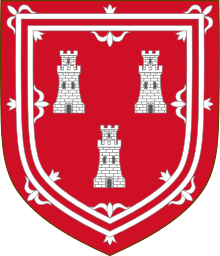Heraldry of Aberdeen

The Heraldry of Aberdeen, Scotland, represents the long history of the city and its people.
Arms
The image of three castles is often present, particularly in the flag and coat of arms of Aberdeen. The symbol has been around since the time of Robert the Bruce and represents the three buildings that used to stand on the three hills of Aberdeen; Aberdeen Castle on Castle Hill, a castle on Windmill Hill and St. Katherine's Chapel (dedicated to Saint Catherine of Siena and founded in 1242 by John Kennedy of Kermuck, a Constable of Aberdeen Castle,[1] but gone by the time Parson Gordon of Rothiemay drew up his Map of Aberdeen in 1661[2]) on St. Katherine's Hill (now levelled).[3]
Conversely the image of a single castle, rather than the triple, is often used in the city. Notably they can be seen in the city educational institutions of Aberdeen Grammar School, Robert Gordons College and the University of Aberdeen.
The coat of arms have been displayed on the city's seal since 1430.[4] In 1672 the Parliament of Scotland passed an act requiring all persons or bodies using coats of arms to matriculate them in a register maintained by Lord Lyon King of Arms. Accordingly, the arms of the "Royall Burgh of Aberdein" were recorded in Lyon Register on February 25, 1674.[5][6] The blazon of the arms was:
Gules, three towers triple-towered within a double-tressure flowered and counterflowered argent. Supported by two leopards proper; and in an escrol above "Bon Accord"

The double tressure surrounding the three castles is derived from the royal arms of Scotland, and was traditionally said to have been granted to the city by Robert I, but may only date from the reign of James I

The supporters are two leopards. According to legend the beasts were granted by James I to Aberdeen as the burgh underwrote his expenses while in exile in England.[6] The city's local magazine is called the "Leopard" and when Union Bridge was constructed in the 19th century small statues of leopards in a sitting position were cast and placed along its railing tops.
Due to local government reorganisation, the arms have been rematriculated twice: in 1976 by the City of Aberdeen District Council, and in 1996 by Aberdeen City Council.[7][8] As such, the arms are the corporate property of Aberdeen City Council.
Motto
The motto of the city is Bon Accord, French for "Good Agreement". Legend tells that its use dates from the 14th century password used by Robert the Bruce during the Wars of Scottish Independence, when he and his men laid siege to Aberdeen Castle before destroying it in 1308 and massacring the English Garrison, retaking Aberdeen for the townspeople. The secret phrase to initiate the campaign was "Bon Accord".[9]
The city's official toast is "Happy to meet, sorry to part, happy to meet again - Bon Accord!", which incorporates words from the Masonic poem "The Final Toast".
The motto should also not be confused with that of Aberdeen Grammar School, which is Bon Record.
References
- ↑ Aberdeen Today. "St Katherine's Hill". Retrieved 2007-05-20.
- ↑ "Aberdeen Civic Society: Round and About 1". Retrieved 2007-05-20.
- ↑ Gazetteer for Scotland. "Aberdeen City". Retrieved 2007-05-15.
- ↑ "New Tolbooth exhibition puts unique spotlight on Aberdeen’s castle". 2006. Retrieved 2007-01-30.
- ↑ A C Fox-Talbot, The Book of Public Arms, 2nd edition, London, 1915
- ↑ 6.0 6.1 R M Urquhart, Scottish Burgh and County Heraldry, London, 1973
- ↑ R M Urquhart, Scottish Civic Heraldry, London, 1979
- ↑ R M Urquhart, Scottish Civic Heraldry 2, Hamilton, 2001
- ↑ Keith, Alexander (1987). A Thousand Years of Aberdeen. Aberdeen: Aberdeen University Press.
| |||||||||||||||||||||||||||||||||||||||||||||||||